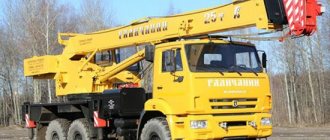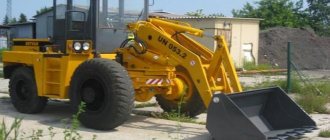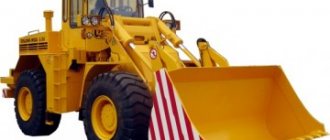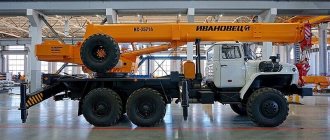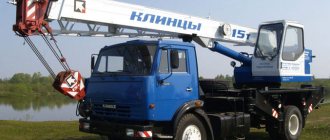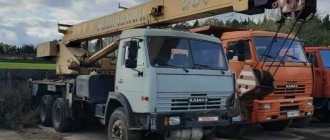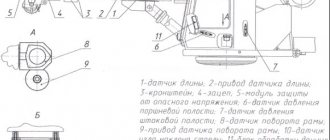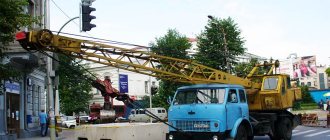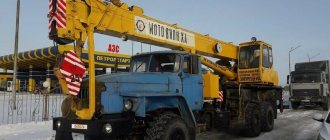Truck crane ZIL-130: technical characteristics
The ZIL-130 truck crane is available in several modifications. Vehicles are used to produce equipment with a carrying capacity of one to sixteen tons. Construction equipment is mounted on three or two-axle chassis of production vehicles. As a result, the equipment receives all the advantages of the basic ZIL-130 and can perform additional operations.
The drive of the truck crane mechanisms is carried out from the car engine. There are three types of drives:
- mechanical;
- electric;
- hydraulic.
Mechanization of equipment is carried out mainly through a hydraulic drive. Various cranes use hydraulic jacks and a basic hydraulic drive. The crane system itself is a slewing bearing device on a roller track. There are several main models of truck cranes based on ZIL-130:
The equipment differs in load capacity and the drive used for crane equipment. The latest model was outdated morally and technically, as it was powered by a mechanical drive. Today on the market there are versions with the letter “K” and a hydraulic device. The lifting capacity of the equipment is 6.3 tons.
Among other construction vehicles, a truck crane based on the ZIL-130 is distinguished by its transport speed, reaching almost 70 km/h. The maximum lifting height of the boom can reach 15 meters, and the lowering height can be eight meters. The main purpose of the equipment is to move cargo with its preliminary capture by the crane's cargo equipment.
Working equipment
The main working equipment on ZIL-130 cranes is a retractable or non-retractable boom. The movable section of the boom operates on pneumatic cylinders, and retraction is carried out by the boom rope. Power take-off for starting working equipment can be done from the gearbox or through a gearbox specially designed for this purpose.
Basic technical data
- base car - ZIL-130;
- base chassis power - 110 kW;
- basic boom equipment as standard - retractable boom, non-retractable boom;
- replaceable boom equipment as standard - extended boom, extended boom with jib;
- main boom length - 8000 mm;
- minimum main boom radius - 3300 mm;
- maximum main boom reach - 7000 mm;
- load capacity at the smallest boom radius on outriggers - 6.3 t;
- load capacity at maximum boom radius on outriggers - 1.9 t;
- load capacity at the smallest boom radius without outriggers - 1 t;
- load capacity at maximum boom radius without outriggers - 0.3 t;
- load capacity in transport position while driving - 1.6 t;
- the minimum speed of lifting/lowering the load is 0.4 meters per minute;
- maximum speed of lifting/lowering the load - 13 meters per minute;
- rotation speed - 0.1-2.5 rpm;
- change in boom radius - 11 meters per minute.
dimensions
- length in transport position with retractable boom - 8500 mm;
- length in transport position with a non-retractable boom - 10,600 mm;
- width - 2500 mm;
- height - 3600 mm;
- operating weight - 9.25-9.53 tons depending on the model.
Get an advantageous offer from direct suppliers:
Truck crane "Klintsy" KS-45719-5A (MAZ-5337, 4×2) 20t
View in Price
Description of the Klintsy KS-45719-5A truck crane based on the MAZ-5337, with a lifting capacity of 20 tons:
Models of truck cranes of the KS-45719-5A series were developed taking into account the wishes often expressed by consumers for new cranes. A distinctive feature was the enlarged support contour, as well as a lightweight boom. These innovations in the design of the truck crane made it possible to provide excellent stability when working with loads, as well as unsurpassed cargo-altitude characteristics on medium and long ranges. The truck crane is capable of using the load lifting mode with the outrigger beams retracted, which is undoubtedly a necessary option for working in the city. The main distinctive feature of the KS-45719-5A model truck cranes is the ability to work in a 360-degree circular zone, which allows you to provide a 100% working area and perform work with a minimum number of rearrangements.
All truck cranes are hydraulic and are designed for loading, unloading, construction and installation work at dispersed sites with various types of access roads. Good maneuverability and small dimensions allow these cranes to be successfully used in cramped conditions of modern cities.
The crane installation is driven by an axial piston hydraulic pump, which is driven by the engine of the base vehicle. The crane mechanisms have an individual drive with independent control from hydraulic motors and hydraulic cylinders. The hydraulic system of the crane installation provides smooth control of all mechanisms with a wide range of speed control for working operations, as well as the ability to simultaneously combine several crane operations.
Important The most popular Xingtai mini tractors come from China
The cranes are equipped with a three-section telescopic boom with a length of 9 - 21 m, which in the RETRACTED position provides the crane with compactness and maneuverability when moving, and in the extended position it provides a large working area and a greater height of movement of the load during operation. The jib is transferred from the working position to the transport position and back without the use of additional lifting equipment. The ability to extend a boom with a load on a hook weighing up to 6 tons allows the crane to perform tasks such as installing loads in hard-to-reach places and transferring them among already constructed structures. Outriggers with folding beams, which are used on truck cranes KS-45719-5A and KS-45719-8A, provide the maximum size of the support contour.
Safe operation of the crane can be ensured by a complex of devices and instruments, among which it should be noted a microprocessor load limiter with a digital indication of operating parameters; all data will be displayed on the display in the operator’s cabin. This device automatically protects the crane from tipping over and overloading. The truck crane is equipped with a crane protection system necessary for working in cramped conditions, and a built-in telemetric memory unit (“black box”) and a crane protection module from dangerous voltage (MZON) are installed for working near power lines.
Load-height characteristics of the Klintsy KS-45719-5A truck crane based on the MAZ-5337, with a lifting capacity of 20 tons:
Technical characteristics of the Klintsy KS-45719-5A truck crane based on the MAZ-5337, with a lifting capacity of 20 tons
| Name of parameters | KS-45719-5A MAZ-5337 |
| Maximum load moment, t/m | 64 |
| Maximum load capacity, t | 20 |
| Boom length, m | 9-21 |
| Jib length, m | 7,5 |
| Jib installation angle, degrees 0/30 | + /- |
| Crane operating area, degrees | 360 |
| Maximum hook lifting height, m | |
| — with main boom 21.0 m — with main boom 21.0 m and jib 7.5 m | 21,6 29,3 |
| Max, depth of hook lowering from ground level, m: | |
| — boom 9 m, reach 5.7 m, reeving 6-fold | 14 |
| — boom 9 m, reach 5.7 m, 4-fold reeving | 28 |
| Load lifting and lowering speed, m/min | |
| — nominal (with a load of up to 20 tons) | 7,0 |
| — increased (with a load of up to 4.5 tons) — maximum (pulley multiplicity 1) | 9,1 40 |
| Load landing speed, m/min | no more than 0.4 |
| Turntable rotation speed, rpm | up to 1.2 |
| Maximum load weight during telescoping, t | 6,0 |
| Fan travel speed under its own power, km/h | up to 80 |
| The size of the support contour along x across the chassis axis, m - with the outrigger beams extended | 5.25 x 5.8 |
| — with retracted outrigger beams | — |
| Fan mass in transport position, t | 18,2 |
| Wheel formula of the base car | 4×2 |
| Base vehicle engine: - model | diesel YaMZ-236NE |
| — power, hp | 230* |
| Dimensions of the crane in transport position, m length x width x height | 11,3×2,5×3,7 |
| Operating temperature, degrees. WITH | from -40 to + 40 |
Truck crane KS-2561: technical characteristics, 2561K, 2561D, ZIL-130, price, analogues
The kinematic diagram includes a reversible distribution mechanism. The control of the reversing distribution mechanism and winches is both mechanical, and with the clutch it is pneumatic. The control of the load limiter actuator (LOL) is electro-pneumatic. The air is supplied from the air cylinders of the vehicle chassis brake system. The boom and load lifting mechanisms are equipped with electrically controlled band normally closed brakes; The mechanism for turning the crane platform is a permanently closed brake. Controls and instrumentation are located in the cockpit.
Technical characteristics of the KS-2561 truck crane
The KS-2561 truck crane is based on the chassis of a commercial truck produced by the Likhachev plant ZIL-130 and 433362. The machine is designed to move single loads weighing up to 6.3 tons during the construction of low-rise buildings, as well as to perform repair or restoration work on water supply lines. The 2561M model, mounted on a ZIL-131 chassis with drive to all axles, was produced in small batches.
Specifications
The truck crane consists of a chassis, which is a special chassis of the ZIL-130 truck, and a load-lifting rotary unit. The crane installation includes a support frame equipped with outriggers. A rotating device is installed on top, on which the boom equipment, working winches and operator’s cabin are located.
Weight data of the KS-2561 crane and technical characteristics:
- engine type - carburetor V-shaped;
- number of cylinders - 8;
- rated power - 150 hp;
- fuel reserve (gasoline A-80) - 150 l;
- transmission - 5-speed manual;
- weight of the crane in working condition (depending on the version) - 8700-9010 kg.
Description of the differences between the chassis and the base truck:
- the exhaust system muffler was moved under the front bumper, and the exhaust gas outlet lines were changed accordingly;
- a special power take-off gearbox is installed on the gearbox;
- the clutch drive has a backup control located in the operator’s cabin on the crane installation;
- The chassis braking system was redesigned and the receivers were moved to new locations.
dimensions
The overall dimensions of the KS-2561 crane allow the machine to be used in dense urban areas. The equipment is capable of working near power lines; the machine has a special device in its design that warns the operator when the boom approaches the wires at a dangerous distance.
The KS-2561D machine in the transport position has the following overall characteristics:
- length (depending on the size of the boom) - 10600-15500 mm;
- width - 2500 mm;
- height - 3600-4700 mm;
- approach/departure angle - 32/25°;
- distance between outriggers - 3600 mm.
Engine
The ZIL 431412 was equipped with a time-tested 4-stroke gasoline unit ZIL-508.10 of its own production. The engine had a 2-chamber carburetor with an inertial oil filter, complemented by a 2-stage air cleaning, falling mixture flow and a forced idle economizer.
Design features:
- cast iron cylinder block with rubber seals and easily removable insert liners;
- aluminum pistons;
- mixed lubrication system (pressure, splash);
- forced crankcase ventilation;
- closed liquid cooling system.
Characteristics of the ZIL-508.10 engine:
- working volume – 6 l;
- rated power - 110.4 (150) kW (hp);
- maximum torque – 402 Nm;
- compression ratio – 6.5;
- number of cylinders – 8 (V-shaped arrangement);
- cylinder diameter – 100 mm;
- specific fuel consumption – 313 (230) g/kW per hour (g/hp per hour).
The ZIL 341412 fuel tank could hold up to 170 liters of fuel. Taking into account the average fuel consumption at a speed of 60 km/h (25.8 l/100 km), one refueling was enough for 650-680 km of travel.
Truck crane KS 2571A
KS 2571A is a small-sized truck crane developed in the 1960s. This model was considered the most popular special equipment during the USSR, as well as in the post-Soviet space. Despite the end of production in the early 1990s, this truck crane continued to be in demand - largely due to its simple and unpretentious design, high maintainability and cheap spare parts. From this point of view, the KS 2571A special equipment has not lost its advantages, and is still in steady demand in the supported market. During the years of production, the machine was indispensable and was widely used in installation and construction work. The equipment has proven itself well in hard-to-reach places where it was necessary to carry and transport large loads over long distances.
Device
The wheelbase of the ZIL 341412 did not change in comparison with its predecessor (4 to 2), which made it possible to use the vehicle on unpaved surfaces in areas where there were no roads at all. High cross-country ability was achieved thanks to the installation of wheels with automatic tire pressure adjustment.
On later modifications of the ZIL 341412, a reinforced frame was installed, making the structure resistant to increased loads. The change made it possible to mount heavy superstructures and transport larger loads. The type of suspension has not changed. The equipment was equipped with front and rear suspension on semi-elliptical springs with sliding rear ends. The front suspension also received shock absorbers.
Description and purpose
KS 2571A is a crane unit based on the Soviet medium-duty truck ZIL-130 with a powerful eight-cylinder engine. The equipment is perfectly adapted to domestic conditions; it is quite compact and maneuverable by cargo standards. Despite the relatively outdated design, this device is still used in some countries by the emergency services - for example, in case of fires and rubble. KS 2571A is an indispensable tool in the construction industry. The maximum lifting capacity of the truck crane exceeds 6 tons, which is a record among medium-tonnage models of that time. This model embodies the most advanced developments and technologies of the Soviet era, from which the active development of Russian special equipment began.
Modifications
The Likhachev plant produced the truck crane of the same name in four modifications. So, in addition to the KS 2571A, the KS2561-K, as well as the KS2561-K1 and KS 2561-E models were produced on the basis of the ZIL-130. They were distinguished by a certain set of functionality, and in terms of design it was still the same ZIL-130 of the 1960s. The most technically advanced models were truck cranes with the index “K” in the name. KS 2571A is a deeply modernized truck crane that has absorbed the best advantages of its predecessors and also received some innovations.
History and modifications
To begin with, it is worth noting that the production of cars began in the mid-50s of the last century at the Likhachev plant. Over the almost fifty years of the existence of the Soviet brand, many different models and modifications of the ZIL 130 were produced, which were widely used in many economic areas. In the 70s, the car was even awarded the “State Quality Mark” award, for which many well-known machine-building plants competed.
Looking directly at the ZIL 130 truck crane, it must be said that its development began in the early 60s, and the first model was called KS 2571A. According to the plant management, it was the crane of this series that was the most popular construction device not only in the Soviet Union, but also in many countries in the post-Soviet space. The production of special equipment ended around the early nineties after the collapse of the USSR due to lack of funding, but even the old models of truck cranes continued to be very popular among builders.
On the basis of the ZIL 130 vehicle, many additional devices were created, which were intended both for construction work and for the fire, medical and agricultural sectors. As for the truck crane, it also has several modernized options.
Let's take a closer look at them:
- The most popular series is considered to be KS-2571, which includes models KS-2571A based on the ZIL-433362 and KS-2571A-1, based on the ZIL-431412.
- The KS-2571B model was produced on the basis of the ZIL-433362 with an additional power plant. It is worth noting that this truck crane was developed at the Stavropol Automobile Plant and is the latest crane of the KS series.
Technical characteristics of KS 2571A
- Base – ZIL-130
- Engine power – 110 kW
- Boom equipment: telescopic type, with rigid suspension
- Boom parameters (reach) – from 1.9 to 10.2 m
- Boom length – from 7.3 to 11 meters
- Load capacity on outriggers – from 0.8 to 6.3 tons
- Load capacity without outriggers – from 0.2 to 2 tons
- Load lifting/lowering speed – 13 m/min
- Maximum speed – 75 km/h
- Dimensions, mm: Length – 9.1, Width – 2.5, Height – 3.2 meters
- Weight – 10.68 tons.
Truck crane "Chelyabinets" KS-55733-26 Kamaz 43118
| Engine Kamaz 740.705-300 | |
| engine's type | Diesel with turbocharging and exhaust gas treatment system |
| Number and arrangement of cylinders | 8, V-shaped |
| Cylinder displacement, cm3 | 11762 |
| Compression ratio | 18 |
| Maximum power, kW | 221 (300 hp) |
| Maximum torque, N*m | 1275 |
| Fuel | Diesel |
| Technical characteristics of the Chelyabinets KS-55733-26 truck crane on the KamAZ 43118 chassis | |
| Basic chassis | Kamaz 43118 |
| Chassis wheel formula | 6x6 |
| Overall dimensions, m | 12 x 2.5 x 3.75 |
| Turning radius, m | 12,1 |
| Gross weight, tons | 22,0 |
| Load distribution, tf: | |
| 5,8 | |
| 16,2 | |
| Technical characteristics of the crane installation | |
| Maximum load capacity, t | 32 |
| Maximum load moment, tm | 102,4 |
| Maximum lifting height on the boom, m | 25,7 |
| Boom radius, m | 25 |
| Boom length, m | 10,75…26,7 |
| Load lifting (lowering) speed, m/min. | 5,45 — 11 |
| Landing speed, m/min | 0,2 |
| Maximum lowering depth, m | 34 |
| Rotation speed, rpm. | 0,1…1,1 |
Important Technical characteristics and design features of the KamAZ-55111 dump truck
The KS-55733-24 Chelyabinets truck crane with a lifting capacity of 32 tons is now mounted on the most common serial all-terrain chassis KAMAZ-43118 (6x6). FOR THE FIRST TIME, a crane unit with such a lifting capacity is installed without overload on the axles, preserving all the qualities of such an all-terrain production vehicle! The approach and departure angles of the machine make it possible for the crane to operate in areas with undeveloped road infrastructure. The geometric maneuverability of the crane in the transport position makes the new machine ideally suited for movement in the most difficult road conditions. The low center of mass and the location of the outriggers of the outriggers in the transport position (the outriggers are as close as possible to the wheels of the chassis balance trolley) improve the cross-country ability of the truck crane as an SUV. The boom is 26.7 meters long, three-section, octagonal in shape, made of high-strength steel S700. The excellent load characteristics of the KS-55733 crane allow consumers to replace the work performed by two standard 25-ton cranes.
The basic configuration of the new crane - a modern cabin and joystick control - makes the crane competitive and ergonomic for the operator, fatigue is reduced, and productivity, safety and work efficiency are accordingly increased.
Having no analogues in Russia, “Chelyabinets” KS-55733-24 is a high-performance, multifunctional, mobile truck crane with a lot of innovations.
Innovation:
Original technical solutions for the metal structure of the crane, combined with the use of high-strength steel S700, ensured a low weight of the crane installation. The truck crane is equipped with a 3-section telescopic boom of the new series. The base and boom sections are a metal structure made of two bent sections made of S700 steel. Simultaneous extension of the sections is ensured by a hydraulic cylinder and a pulley mechanism. It is possible to telescope sections with a load on the hook of up to 6 tons. The large support contour ensures the stability of the crane in a 360° working area. In cramped conditions, it is possible to use an incomplete support contour. Low axle loads allow you to maintain excellent handling and maneuverability, increase the service life of the chassis, use fuel efficiently, and travel on public roads and bridges without restrictions or fines.
"Individual crane" concept:
According to the “Individual Crane” concept, a large number of options and designs are available to crane consumers: choice of chassis, installation of additional equipment (heaters, preheaters, navigation systems, fuel protection and control, jib, additional fuel tank, coolers, personal painting in customer colors, application of branded logos and inscriptions and much more).
Features of the device and operation
The equipment has all the advantages of the ZIL-130 car. Depending on the configuration, the truck crane is supplied with a specific drive - mechanical, electric or hydraulic. To mechanize the equipment, a hydraulic drive is provided, which is a rotary support mechanism on a roller motion.
As can be seen in the technical specifications, the lifting capacity of the KS-2571-A can be changed, and, if necessary, the maximum load and the highest boom height can be used. Moreover, the lower the height, the higher the load capacity.
Please note that despite its more massive dimensions and heavy weight, the truck crane turned out to be maneuverable and high-torque. Its top speed is 75 km/h, which is phenomenal in its class even by today's standards. This speed is enough to quickly move between objects, even in cramped urban environments. The equipment is capable of moving cargo over long distances. The role of the main working equipment in the KS-2571-A truck crane is performed by a boom, the height of which can be adjusted using pneumatic cylinders. In this case, the boom is returned to its original (retracted) position using a boom rope. Please note that the pneumatic cylinder operates due to the torque transmitted by the engine through a mechanical transmission. The gearbox ratios are tuned to withstand enormous loads. The additional torque is provided by the power take-off shaft, which also works with the internal combustion engine and gearbox.
KS-2571A-1 is equipped with special devices that can rightfully be considered Soviet-era know-how. In the post-war years, technological progress was actively developing in the USSR, and the truck crane of the same name fell precisely in this era. The car has an advanced design that has become relevant over several decades. The crane installation includes a chassis and boom equipment. The car does not have any innovative electronics, which only benefits the workflow. Ease of control is ensured by the ideal ergonomic location of all instruments and switches, as well as a large steering wheel with pronounced feedback. The operator's cabin is always warm and cozy thanks to the heating system and ventilation system.
The Ks-2751A-1 truck crane is equipped with large off-road tires with deep tread. Here we add even greater suspension travel and durable shock absorbers, as well as a powerful eight-cylinder engine with a high proportion of torque. All this ensures stability and smoothness on any road - from asphalt to serious off-road. The power and capabilities of this truck crane are quite enough to get through the most inaccessible places - for example, where an ordinary passenger car cannot pass. Thus, it is not surprising that the KS-2751A-1 is in demand not only for installation and construction work, but also for the search and development of oil and gas fields.
Characteristics and equipment of truck cranes based on the ZIL 130 truck
Currently, when there is a need to carry out construction and installation work or to load and unload any materials, ZIL boom self-propelled truck cranes are widely used. The main advantages of these mechanisms include the fact that they have an autonomous drive, they are able to quickly change their location, moving from object to object, and they have a large variety of interchangeable equipment. These cranes can be classified by the type of traveler and drive they have, or by the type of boom equipment they use. Taking into account the type of running equipment, they can be grouped into truck cranes, pneumatic cranes and cranes mounted on special chassis.
ZIL truck cranes - main characteristics and equipment
ZIL truck cranes are produced in various lifting capacities, which range from 1 to 16 tons. They are mounted on the base of two- or three-axle truck chassis, which are mass-produced. All mechanisms on such cranes are driven exclusively by the car engine. The drive itself can be mechanical (mostly small sizes), hydraulic and electric. When a truck crane uses the principle of a diesel-electric drive, each mechanism must have an individual electric motor that receives energy from a three-phase generator, and this generator is rotated by the vehicle engine.
For truck cranes, it is mandatory to equip them with devices that ensure safe operation - these devices must limit the load capacity and lifting height of the hook, indicate the angle of the boom, indicate the roll and weight of the lift. Based on the standard “one hundred and thirty”, a whole family of special equipment was created, including truck cranes. Thus, the ZIL truck crane became widely used under the crane emblem KS-2561E. This mechanism had a lifting capacity of 6.3 tons, the drive was mechanical.
This type of truck crane was equipped with a stabilizer and folding outriggers, which are installed using automotive hydraulic jacks. The crane has a roller rotating device. The main boom of the crane is not retractable, it is lattice. But the kit came with two replacement booms, both extended, but one still had a jib. By design, the ZIL 130 truck crane is considered a jib crane.
Maneuverable and economical ZIL truck crane
As the design of the ZIL-130 vehicle improved, subsequent modifications of a similar working vehicle received improvements. With the advent of the ZIL 133GYA truck crane chassis, the KS-3575A model was created, and the KS-3575 crane was developed on the ZIL-133G1 chassis. Both types of transport have a lifting capacity of up to 10 tons. These models of self-propelled cranes have the same chassis, but they differ in the installed engines - a diesel engine type is installed on the first type of vehicle, and a gasoline engine on the second. Truck cranes of these models have a hydraulic drive. They have great cross-country ability and can be successfully used even in narrow streets.
The transport speed of the crane reaches almost seventy-five kilometers per hour. Their maximum lifting height reaches fifteen meters, and the lowering depth is almost eight meters. ZIL truck cranes are classified as cyclic lifting mechanisms, designed to move (in space) a load that is held by a load-handling member. Although the production of these types of cranes has long been discontinued, they are still found in working order and regularly perform all the functions for which they are intended.
